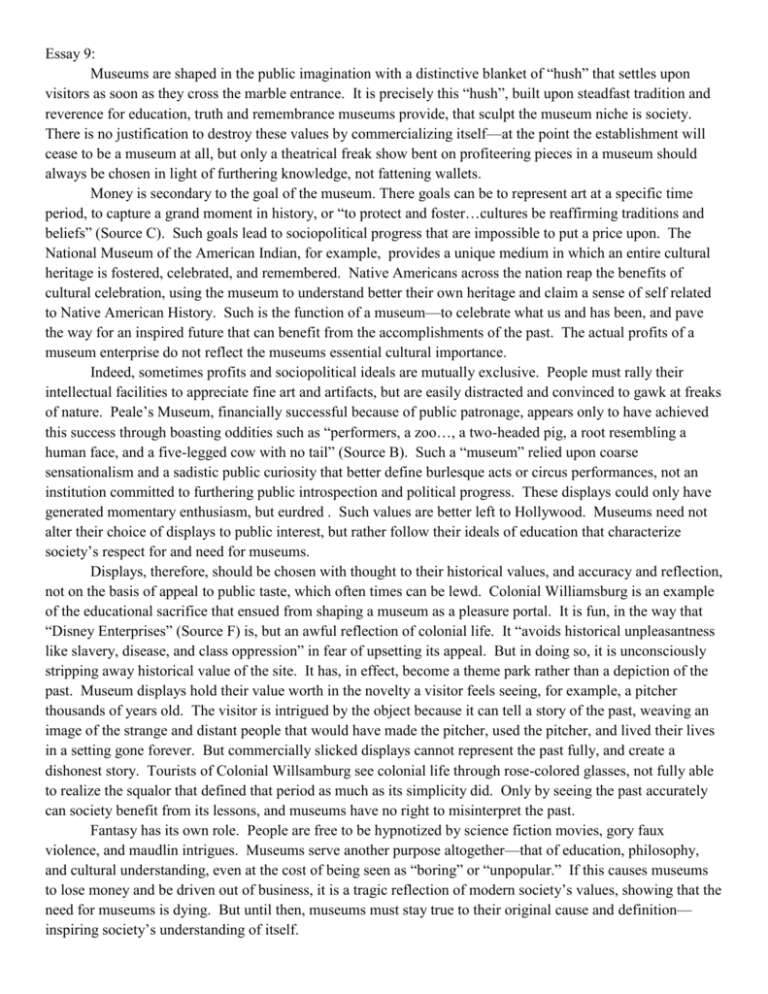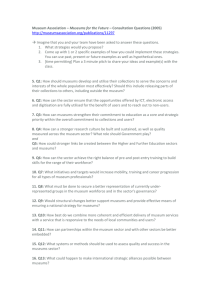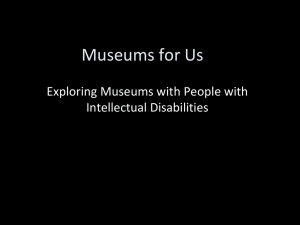Essay 9: Museums are shaped in the public imagination with a
advertisement

Essay 9: Museums are shaped in the public imagination with a distinctive blanket of “hush” that settles upon visitors as soon as they cross the marble entrance. It is precisely this “hush”, built upon steadfast tradition and reverence for education, truth and remembrance museums provide, that sculpt the museum niche is society. There is no justification to destroy these values by commercializing itself—at the point the establishment will cease to be a museum at all, but only a theatrical freak show bent on profiteering pieces in a museum should always be chosen in light of furthering knowledge, not fattening wallets. Money is secondary to the goal of the museum. There goals can be to represent art at a specific time period, to capture a grand moment in history, or “to protect and foster…cultures be reaffirming traditions and beliefs” (Source C). Such goals lead to sociopolitical progress that are impossible to put a price upon. The National Museum of the American Indian, for example, provides a unique medium in which an entire cultural heritage is fostered, celebrated, and remembered. Native Americans across the nation reap the benefits of cultural celebration, using the museum to understand better their own heritage and claim a sense of self related to Native American History. Such is the function of a museum—to celebrate what us and has been, and pave the way for an inspired future that can benefit from the accomplishments of the past. The actual profits of a museum enterprise do not reflect the museums essential cultural importance. Indeed, sometimes profits and sociopolitical ideals are mutually exclusive. People must rally their intellectual facilities to appreciate fine art and artifacts, but are easily distracted and convinced to gawk at freaks of nature. Peale’s Museum, financially successful because of public patronage, appears only to have achieved this success through boasting oddities such as “performers, a zoo…, a two-headed pig, a root resembling a human face, and a five-legged cow with no tail” (Source B). Such a “museum” relied upon coarse sensationalism and a sadistic public curiosity that better define burlesque acts or circus performances, not an institution committed to furthering public introspection and political progress. These displays could only have generated momentary enthusiasm, but eurdred . Such values are better left to Hollywood. Museums need not alter their choice of displays to public interest, but rather follow their ideals of education that characterize society’s respect for and need for museums. Displays, therefore, should be chosen with thought to their historical values, and accuracy and reflection, not on the basis of appeal to public taste, which often times can be lewd. Colonial Williamsburg is an example of the educational sacrifice that ensued from shaping a museum as a pleasure portal. It is fun, in the way that “Disney Enterprises” (Source F) is, but an awful reflection of colonial life. It “avoids historical unpleasantness like slavery, disease, and class oppression” in fear of upsetting its appeal. But in doing so, it is unconsciously stripping away historical value of the site. It has, in effect, become a theme park rather than a depiction of the past. Museum displays hold their value worth in the novelty a visitor feels seeing, for example, a pitcher thousands of years old. The visitor is intrigued by the object because it can tell a story of the past, weaving an image of the strange and distant people that would have made the pitcher, used the pitcher, and lived their lives in a setting gone forever. But commercially slicked displays cannot represent the past fully, and create a dishonest story. Tourists of Colonial Willsamburg see colonial life through rose-colored glasses, not fully able to realize the squalor that defined that period as much as its simplicity did. Only by seeing the past accurately can society benefit from its lessons, and museums have no right to misinterpret the past. Fantasy has its own role. People are free to be hypnotized by science fiction movies, gory faux violence, and maudlin intrigues. Museums serve another purpose altogether—that of education, philosophy, and cultural understanding, even at the cost of being seen as “boring” or “unpopular.” If this causes museums to lose money and be driven out of business, it is a tragic reflection of modern society’s values, showing that the need for museums is dying. But until then, museums must stay true to their original cause and definition— inspiring society’s understanding of itself.






